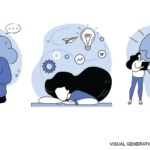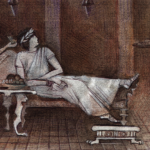Happy New Year, readers of The Rheumatologist! As the incoming editor, I want to welcome you back in this new year and hope that you’ll stick around, month after month, as we journey together through 2023. As the year progresses, you may notice some departures from what we have previously done, but I also wish to reassure you that the spirit, ethos and love that Philip Seo, MD, MHS, and his predecessors imbued into this publication will endure both this year and in years beyond.

Bharat Kumar, MD
Toward that end, January is a perfect time for perspective taking. Some of you may be aware that the name of the month of January is derived from Janus, the Roman god of beginnings and endings. Those of us within the rheumatology community may even be aware that this same Roman god, Janus, is the namesake for the family of tyrosine kinases that we now refer to as JAKs. Janus has also lent his name to something we are less familiar with, but should be embracing in rheumatology: Janusian thinking.
Novel & Yet Intimately Familiar
Janus has been classically portrayed as having two faces looking in opposite directions. Albert Rothenberg, MD, who coined the term in 1971, was inspired by this portrayal and used it to describe a creative process whereby two contradictory concepts, ideas or images are held simultaneously.1 He later investigated Nobel Prize laureates known for their creativity and insightfulness, and found that they embraced this paradoxical way of processing information and viewing the world.2 Unfortunately, none of those he studied were rheumatologists. But I can tell you that some of the most successful rheumatologists are also Janusian thinkers.
It’s a little mind-bending so I’ll bring up a classic example that Dr. Rothenberg mentioned in his article. Albert Einstein, as he was composing his theory of general relativity, identified a core paradox: The magnitude of gravity that is pulling in one direction is equivalent to the acceleration in the opposite direction. To answer this paradox of moving while resting, he constructed a mental framework. An observer who jumps off a roof and releases an object at the same time will not notice any movement because he will not find any evidence of a gravitational field. By extending this metaphor (and remember, I am not a physicist), he derived the concept that gravity and motion can affect intervals of time and space.3
In fact, this introduction to Janusian thinking can be thought of as an example of Janusian thinking in its own right. Indeed, I would wager that only a small percentage of readers are familiar with the term. At the same time, it is likely that you are intimately familiar with what I am talking about. How many times have we been in the clinic and had to reason through a scenario in which we’ve had two contradictory findings at the same time, or been conducting research and had to grapple with unexpected outcomes that directly contradict one another? As patients, how many times have we had to grapple with the duality of risks and benefits? Think about it for a moment and you’ll find instance after instance where this has held true.
Rheumatology Is a Specific Generalization
So far, what I have stated may still seem rather generic. It may even sound a little hokey since everything, if you analyze it too closely, will yield contradictions. But I assure you, Janusian thinking is both generic and specific to rheumatology (see what I did there?). After all, rheumatology is uniquely about the art of resolving paradoxes through innovative thinking. How can autoimmune diseases lead to immune deficiency, and immune deficiency lead to autoimmune disease? How can thicker bones in certain conditions lead to more fractures? How can apoptosis, a way of cell death, be vital to sustaining health?
In fact, even our origins come from some very contradictory grounds: Rheumatology is, loosely, the study of soft tissues. It comes from the ancient Greek word rheuma, meaning river or stream. But tissues are defined by structure, not particularly by softness or riverine tendencies. Generations of rheumatologists and other physicians and researchers helped resolve this dilemma by engaging in inquiry about cells and tissues that may have concrete properties but connect with one another in fluid ways. To me, it makes sense that rheumatology and immunology have become so intertwined.
In the 21st century, that becomes even more contradictory. Vast amounts of genetic information are widely available, and exciting technologies are being disseminated like never before. This is exposing some of the great underlying tensions between different concepts that we have historically thought are contradictory. One example that often provokes heated arguments in conferences is whether rheumatoid arthritis is one disease or many. Certainly, that uncertainty was part of the subtext for the ACR Convergence 2022’s Great Debate, in which the utility of treating pre-RA was discussed. Perhaps, the Janusians would contend, the answer is that RA is both one disease and multiple diseases simultaneously.
Deliberate Trial & Error
Big deal, you may say. We already know that rheumatoid arthritis is a multifaceted condition. It’s self-evident, and it didn’t require any fancy Janusian thinking to get to that point. But is that so? Our rheumatologic forefathers weren’t so confident in such a conclusion. Only in retrospect can we make such certainties. Only because our predecessors worked so hard in the clinics and in the laboratories does that conclusion come to us so easily. By the same token, a few generations down the line, our descendants may not understand the great debates that we held because we are working hard, but largely invisibly, to resolve these contradictions.
Which brings us to another paradox that scaffolds scientific progress: Science, in particular the basic immunology that underpins rheumatology, is based on trial and error. Yet at the same time, we have to be deliberate in what we do to expedite the answering of longstanding and vexing questions. Clearly, there’s a compromise, that puts us on the right path. But is there a way that we can resolve this in a more efficient manner? Janusian thinking is the answer—and also, it is not.
According to Dr. Rothenberg’s article in 1971, Janusian thinking can be split into four phases: 1) motivation to create; 2) deviation from the usual; 3) simultaneous opposition or antithesis; and 4) construction of the theory. Although the specifics go well beyond this column, identifying the problem in a disciplined manner and going through the steps sequentially may lead to a theory that accommodates these contradictions simultaneously.1
Of note, we must not simply play word games with synonyms and antonyms, but go deeper into exploring concepts, aesthetes and styles.4 A genuine motivation and thirst for resolving such contradictions is necessary, but it is also vital to preserve the integrity of both sides of the debate. It’s a deeply personal process, yet it can be expedited by group discussions.
I have found it intensely frustrating to come to that elusive conclusion or—as articulated in the article—theory, but also, oddly, pleasant and satisfying. Coming up with a solution that reduces discomfort requires stewing in discomfort. It necessitates embracing ambiguity at the edges to find clarity at the core. It requires humility to recognize our fundamental limitations in understanding the world, but also hubris in the inherent belief that a better solution can be found. It’s a mind-bending process, but also one that gets me to the core of my being.
Implications
For whatever reason, Janusian thinking is not in the conscience of healthcare professionals, or, for that matter, pop culture. Perhaps it’s because an army of consultants has made creativity a corporate process—such phrases as “think outside the box” and “there are no wrong answers” come to mind.5 Perhaps it’s because our bandwidth is becoming more and more occupied by everyday tasks that we don’t have the mental space to hold two contradictory concepts in our minds simultaneously.6 Or perhaps it’s because, in these trying times, we are trying to hold on to what is familiar.7
Regardless, I think we should set an agenda that promotes Janusian thinking, particularly in medical education. Diagnostic reasoning remains very much a gray area, one in which much research and innovation are taking place.8 Figuring out ways to promote Janusian thinking in rheumatology fellowship is a natural starting point. In the clinic, if we are not doing so already, perhaps we should prompt our fellows to think of contradictory diagnoses that patients can hold at the same time, and then identify next steps to evaluate how both contradictory diagnoses can coexist. I recognize the heterodox nature of this suggestion. Occam’s razor (i.e., plurality is not to be assumed without necessity) is a foundation of diagnostic reasoning.9 But maybe, in Janusian style, it’s time to rethink that assumption while simultaneously holding onto tradition. Feedback and formative evaluation are also rife for exploration using Janusian thinking. After all, feedback is meant to not only foster growth among learners but also to simultaneously reassure them about the degree to which they are progressing.10 Ensuring that both needs can be satisfied at the same time is no easy feat, yet is vital to maintaining high quality of feedback. Personally, as an educator, I often find myself on this tightrope and have been practicing how to resolve this contradiction. I imagine many others of you have as well.
As our community rightfully extends our focus into efforts for diversity, equity and inclusion, we should also embrace this Janusian thinking. How can we meaningfully promote our ideals of unity in diversity?11 Certainly, our world family has been asking this question for thousands of years, and we are tasked with that question today. How can we champion inclusiveness in a world that values exclusivity?12 How can we use our sense of privilege to promote equity?13 How do we reconcile the problematic history that we share with the aspirational future we seek to develop?
These aren’t easy questions, but they are in dire need of exploration. Janusian thinking, with a bent toward inclusivity and an eye toward equity, can help us gain wisdom.
We have already discussed the importance of Janusian thinking in immunologic and rheumatologic research. I feel that many investigators would agree that dynamic tensions and contradictions exist within our field. But how can we promote Janusian thinking in research when most grant applications are structured in ways that unintentionally promote the reduction of complex scientific inquiries into addressing a concrete set of specific aims?14 Although we are more flexible now than we were a decade or two ago, we still have a lot of room to promote Janusian thinking in research.
For me, the most tantalizing potential application of Janusian thinking is in the sphere of well-being and burnout. During the ongoing COVID-19 pandemic, we have embraced working from home. This is, needless to say, an absolute contradiction in terms. It has been personally difficult to simultaneously hold conceptions of work life and home life in one thought, but whenever and whoever figures that out will do a great service for healthcare team members and the lives they live.
Additionally, I often think about the imposterism that I feel in so many aspects of my life. Imposterism—that is, the feelings of self-doubt that persist despite one’s education, experience and accomplishments—is, to my mind, an example of what occurs when two deep-seated, diametrically opposed perceptions of reality clash.15 Like many of you, I strive to reconcile my inadequacies with my accomplishments. Practicing Janusian thinking has brought me a modicum of relief, although I must say that I am still practicing.
The Ending Is Only a Beginning
So here I lead you back to the beginning when I wished you a happy new year. The more things will change at The Rheumatologist in 2023, the more they will remain the same. As the physician editor, I pledge to use Janusian thinking as much as possible to help oversee the creative growth of this publication—to ensure that you, as a reader, find your voice represented in the written words. I hope to live up to the expectations that you set of me, anticipating that I will, on occasion, not be able to do so.
I intend on using this piece of paper and electronic web space to tie together the disparate factions within our rheumatology world by highlighting those things that make us so unique. Along with the rest of the team, I will showcase the beauty of our specialty by celebrating its imperfections and shortcomings. This is an exciting and incredibly daunting time for myself and the world. If ever I needed to invoke Janusian thinking, it would be this January.

Bharat Kumar, MD, MME, FACP, FAAAAI, RhMSUS, is the associate program director of the rheumatology fellowship training program at the University of Iowa, Iowa City. He assumes the reins of physician editor of The Rheumatologist with this issue. Follow him on Twitter @BharatKumarMD.
References
- Rothenberg A. The process of Janusian thinking in creativity. Arch Gen Psychiatry. 1971 Mar;24(3):195–205.
- Rothenberg A. Janusian thinking and Nobel prize laureates. Am J Psychiatry. 1982 Jan;139(1):122–124.
- Michalko M. Janusian thinking: How Einstein conceived the theory of relativity. 2017 Dec 2. LinkedIn. https://www.linkedin.com/pulse/janusian-thinking-how-einstein-conceived-theory-michael-michalko.
- Rothenberg A. The Janusian process in creativity. Psychology Today. 2015 Jun 25. https://www.psychologytoday.com/us/blog/creative-explorations/201506/the-janusian-process-in-creativity.
- Boyd D. Thinking outside the box: A misguided idea. Psychology Today. 2014 Feb 6. https://www.psychologytoday.com/us/blog/inside-the-box/201402/thinking-outside-the-box-misguided-idea.
- Mullainathan S. The mistake busy people make. Time. 2013 Sep 9. http://ideas.time.com/2013/09/09/the-mistake-busy-people-make.
- Litt A, Reich T, Maymin S, Shiv B. Pressure and perverse flights to familiarity. Psychol Sci. 2011 Apr;22(4):523–531.
- Goldowsky A, Rencic J. Self-regulated learning and the future of diagnostic reasoning education. Diagnosis (Berl). 2022 Dec 8. doi: 10.1515/dx-2022-0066.
- Kelly J. The diagnostic approach in complex patients: Parsimony or plenitude? Am J Med. 2021 Jan;134(1):11–12.
- Bok HG, Jaarsma DA, Spruijt A, et al. Feedback-giving behaviour in performance evaluations during clinical clerkships. Med Teach. 2016;38(1):88–95.
- Pinto AD. Can a focus on equity, diversity and inclusion transform health services research? Healthc Pap. 2022 Apr;20(3):53–60.
- Park BC, Quach WT, Drolet BC. The reevaluation of AΩA: Updating the outdated. J Surg Educ. 2022 Nov–Dec;79(6):1320–1323.
- Patnaik R, Attlassy N, Davids S, Fletcher KE. A reflection and discussion exercise on racial justice and equity. J Grad Med Educ. 2022 Oct;14(5):554–560.
- Fahrenholz M, Cheng LS, Olutoye O 2nd, et al. Ancillary documents for NIH grant applications: The pages beyond the science. Surgery. 2022 Nov 15:S0039-6060(22)00856-X.
- Morgenstern BZ, Beck Dallaghan G. Should medical educators help learners reframe imposterism? Teach Learn Med. 2021 Aug–Sep;33(4):445–452.


